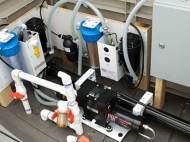| What if solar energy could be used to distill salt water? That’s what engineers at MIT are developing, in a design that not only saves electricity but avoids filter clogging. |
State-of-the-art technology requires around 3.5 megawatt-hours to desalinate one acre foot of seawater.
Cambridge, Oct. 25 (DP.net).– OceanWell, a company testing a design takes advantage of the pressure differential between shallow and deep water to bring the energy requirement down to just over 2 MWh/AF (ref. WC #8). Using filtration technology, the theoretical minimum is 1.2 MWh/AF. 
But what if solar energy could be used to distill salt water? That’s what engineers at MIT are developing, in a design that not only saves electricity but avoids filter clogging. Using MIT’s numbers, a one square mile array could produce around 90,000 acre-feet a year of fresh water from seawater. The design also may be able to extract fresh water while releasing only slightly saltier brine, and by avoiding filtration, would avoid any contaminants filters might otherwise introduce.
In a paper appearing today in the journal Joule, a team of engineers at MIT outlines the design for a new solar desalination system that takes in salt water and heats it with natural sunlight.
The configuration of the device allows water to circulate in swirling eddies, in a manner similar to the much larger “thermohaline” circulation of the ocean. This circulation, combined with the sun’s heat, drives water to evaporate, leaving salt behind. The resulting water vapor can then be condensed and collected as pure, drinkable water. In the meantime, the leftover salt continues circulating through and out of the device, rather than accumulating and clogging the system.
The new system has a higher water-production rate and a higher salt-rejection rate than all other passive solar desalination concepts currently being tested.
The researchers estimate that if the system is scaled up to the size of a small suitcase, it could produce about 4 to 6 liters of drinking water per hour and last several years before requiring replacement parts. At this scale and performance, the system could produce drinking water at a rate and price that is cheaper than tap water.